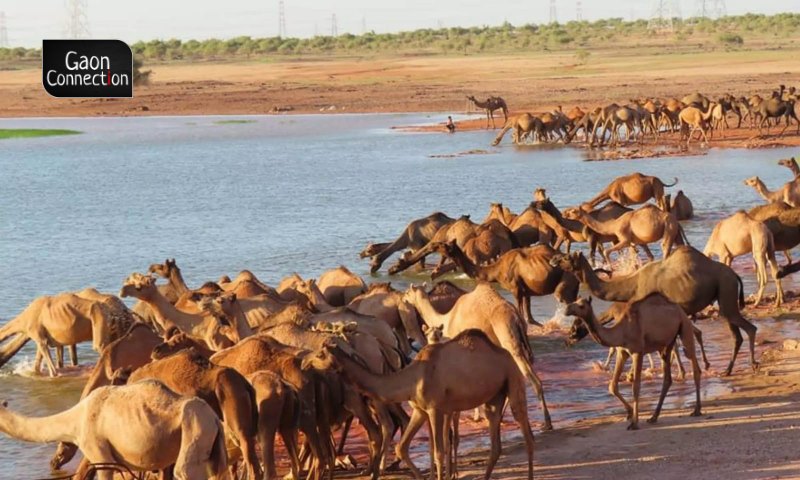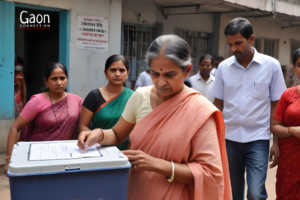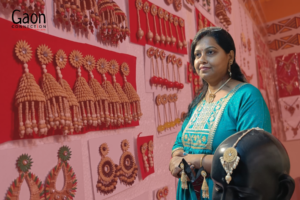Jaisalmer, Rajasthan
Even up to five years ago, Joraram Raika owned 200 camels. Today, the camel herder from Achla village in Jaisalmer, has only 70 camels left.
“It is getting increasingly difficult to rear camels. The grazing lands are disappearing. The Orans [sacred groves], that used to be a haven for animals and birds with their grazing lands, water sources have been appropriated by companies setting up solar power plants…” Joraram trailed off despondently. Raikas are the traditional camel herders of Rajasthan.
The 58-year-old Raika told Gaon Connection that while he did not have the heart to sell his camels, the expense of keeping them would lead him to starvation. The camel herder, who has two sons and three daughters, struggles to farm on a part of his 25 bigha land which, due to the lack of water, yields very little. He also grazes his camels on the land.
Also Read: Rajasthan: Camels and sheep to face a fodder crisis as about 600-year-old Oran is being uprooted
The camel, also known as the ship of the desert, is floundering as the winds of change sweep across Rajasthan. Their numbers have dwindled alarmingly.
According to the 20th Livestock Census of the Department of Animal Husbandry & Dairying, which was released in October 2019, between 2012 and 2019, the population of camels in the country reduced by 35 per cent.
In 2012, there were 0.4 million camels in India and by 2019, the numbers reduced to 0.25 million. In 2012 there were 0.19 male camels and 0.21 female camels (cows). By 2019, the numbers had reduced to 0.08 million and 0.17, respectively.
In Rajasthan, the state’s total camel population has dropped from 325,713 in 2012 to 212,739 in 2019.
Also Read: ‘Green’ energy projects threaten to wipe off ancient ‘orans’ in Jaisalmer, Rajasthan
“The ship of the desert is in danger of sinking,” Puran Singh Sodha from Sodhan village in Jaisalmer said emotionally. He pointed out how the camels covered miles with ease over the blistering desert sands.
“The Gomath breed of camels are the best for transportation, while the Bikaneri breed is considered the best to carry loads,” the 45-year-old camel herder told Gaon Connection. He pointed out that camel milk was considered to be beneficial to treat several ailments and it sold at Rs 200 to Rs 300 a litre.
Established in 1984, the ICAR-National Research Centre on Camel Camel Research in Bikaner, Rajasthan, has been studying the benefits of camel milk. The centre also provides training capsules to camel rearers on making products from the camel milk.
A friend in need
The camel that is also the state animal of Rajasthan is employed by Indian para military forces for border patrol.
According to the state archives, it was in 1889 that the Bikaner Camel Corps or the Ganga Risala was established by Maharaja Ganga Singh of Bikaner, which became a part of the Imperial Army of the British.
Camels have covered themselves in glory in several historical battles including the Boxer Uprising in China in 1900, the Somaliland campaign from 1902 to 1904, the First World War between 1914 and 1919, and the Second World War from 1939 to 1945. Maharaja Ganga Singh, in fact, commanded the Bikaner Camel Corps which took part during the First World War.
“The camel is a faithful companion. It is low maintenance and hard working. The animal can go for days without food and water,” Jugat Singh, a retired jawan from the Border Security Force (BSF), living in Ranau village in Jaisalmer, told Gaon Connection.
“Camels have countless number of times carried away wounded soldiers from the battlefields to safety,” Singh, who had a long association with the camels when he was in the BSF, added.
The camels were also lifesavers for desert inhabitants during the terrible Chhapaniya Famine in 1899-1900. They were used to plough, carry loads and cross great stretches of the inhospitable Thar desert for centuries.
Also Read: Lockdown woes: Many camels in Rajasthan are succumbing to a contagious skin disease
The mainstay of tourism
“We had two camels at home and we played around them,” fondly remembered Tanerao Singh Damodara from Jaisalmer. “Until recently, camels were integral to the lives of those who live in these parts. It was a matter of prestige to own camels,” Damodara, who has a tourist-related business, told Gaon Connection.
But not any more. “Tourist operators are worried at the dwindling population of camels that are a great draw for those looking for camel safaris.The camels are decorated finely and are favourites at photo shoots,” he added.
The mainstay of Rajasthan’s economy is tourism and tourists from home and abroad throng Jaisalmer, dreaming of a camel safari. Camel safaris for the tourists are a significant contributor to the local economy and livelihoods of the people.
Now, more and more camel rearers, daunted by the expenses of maintaining their herds, are giving up rearing camels. “It costs anything between thousand to fifteen hundred rupees to maintain each camel per month,” Sumer Singh Sanwta, a camel herder from Jaisalmer, told Gaon Connection. With income from camels drying up, the expense is too much for most camel herders to bear, he explained.
Also Read: Pushkar’s camel fair is back after a two-year hiatus, but the response to it is lacklustre
Hotels that hired camels from them to entertain guests are no longer doing so; the popular camel safaris are drying up; and it is becoming increasingly difficult to even sell the camels because of governmental restrictions. “There is no more viable income to be made from the camels,” rued Sumer Singh.
Ban on camel trade hurting camel herders
On June 30, 2014, the Rajasthan government declared the camel to be the state animal. A year later, in 2015, the government introduced the Rajasthan Camel (Prohibition of Slaughter and Regulation of Temporary Migration or Export) Act, that prohibited camel slaughter and regulated temporary migration or export of camels from Rajasthan.
However, this has affected the camel rearers whose main source of income came from selling their camels to farmers who used them for ploughing, the tourism industry that used them to entertain guests, etc. A camel can sell for anything up to a lakh of rupees each.
In October 2016, the Rajasthan government launched the Ustra Vikas Yojana, a Camel Development Scheme, under which the camel farmer was to be paid Rs 10,000 on each calf born irrespective of any breed of camel, in three instalments.
However, the scheme did not work out as expected and it stopped in 2020. The camel rearers who were to receive the grant claimed that they did not get all three instalments as promised and there were several agitations over this. On March 10, 2021, camel rearers gheraoed the authorities of the animal husbandry department, Jaisalmer. They alleged that there were a lot of irregularities in releasing the grant.
Also Read: The desert coolers of Rajasthan
In the face of rising allegations and protests, the animal husbandry department assured the camel rearers that a committee would look into the matter and their problems would be resolved soon. However, nearly a year on, nothing has been done, alleged some camel herders.
“Under the Ustra Vikas Yojana, approximately four crore rupees were sanctioned,” Manoj Mathur, deputy director, animal husbandry department, Jaisalmer, told Gaon Connection. “An inquiry will be conducted soon on the allegations of corruption against the field workers of the department and the matter will be soon resolved,” he added.
The pandemic has further worsened matters. The world renowned Pushkar fair in Jaisalmer, Rajasthan, could not be held as scheduled and tourism on the whole ground to a halt. In 2021, when the Pushkar fair resumed, the business was next to nothing, the camel traders said.
According to the data of the animal husbandry department, of the 2,327 camels brought to the Pushkar Mela only 426 could be sold. These are numbers that are a stark contrast to the times when camel trade flourished. In 2001 the Pushkar Mela saw 15,460 camels being bought and sold.
Read the story in Hindi.
















